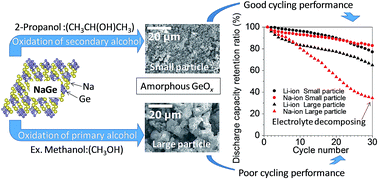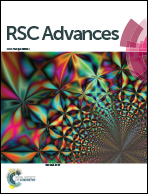Electrochemical performance of highly amorphous GeOx powders synthesized in different alcohols for use in Na- and Li-ion batteries†
Abstract
We synthesized highly amorphous GeOx powders by a solution synthesis method, in which NaGe was oxidized by alcohol and placed in distilled water. Further, we investigated the effect of the alcohol used during the solution synthesis method on the electrochemical Na- and Li-ion insertion/extraction performances of the powder sample. We compared the oxidation process as performed using various alcohols. The amorphous GeOx powder sample synthesized by oxidation in 2-propanol (secondary alcohol) exhibited good electrochemical performance with respect to Na- and Li-ion insertion/extraction, while the amorphous GeOx powders synthesized using methanol, ethanol, and 1-propanol (primary alcohol) showed poor performances. These powders consisted of large particles, which was the reason for their poor electrochemical performance. In particular, their cycling performance in a Na-ion cell was significantly lowered by the large particle size. Hence, during the solution synthesis process, the use of a secondary alcohol is the key to synthesizing highly amorphous GeOx powders with small particle sizes. Finally, electrolyte decomposition was also found to be one of the main causes for the deterioration of the cycling performance in a Na-ion cell, because the change in the volume of the GeOx particles during charging/discharging was smaller in the Na-ion cell than in a Li-ion cell.


 Please wait while we load your content...
Please wait while we load your content...